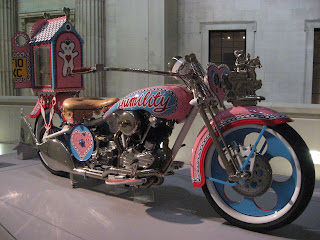 |
| Grayson Perry: The Tomb Of The Unknown Craftsman |
Don't look too hard for meaning here.
i am not a historian, i am am artist. That is all.
When i was young I had an imaginary civilisation.
I became an artist and my civilisation traded with the world and all its history.
Now i am not sure where my imagination stops and the world starts.
Deep in the mountains of my mind there is a scared place where is a monument to skill.
The tomb of the unknown craftsman is just as real as everything else in this museum,
the ideas and beliefs behind it and just as real.
You are real pilgrims.
That i am an artist and not a historian and this is an art exhibition does not mean it is any less real.
Reality can be new as well as old, poetic as well as factual and funny as well as grimes.
The tomb of the unknown craftsman could be another name for the British museum.
 |
| Kenilworth Am1 |
 |
| Kenilworth Am1 |
 |
| Kenilworth Am1 |
Grayson Perry, an English artist, famous on his beautiful ceramic vases and transvestite. i think this is the first time British Museum held a contemporary artist exhibition.
before you come in the show room, you would see an exaggerating and colourful motobike. Garyson and his pope Alan Measles rode this bike to Germany as a trip to gain famous of Alan Measles.
inside, there are many heritages, ancient items and of coure, Grayson Perry's work. this exhibition is extremely thought provoking and clever. i almost write down every single word that Perry explained for his show.
there is another quotation i like, especially the bold words :
few civilisation spring up spontaneously or develop in isolation. culture borrow and adapt. i enjoy artefacts where this give and take in more obvious and dissonant. new religions try to recruit by using the sites and symbols of the belief system they are trying to replace. craftsmen make artefacts they think will appeal to visitors from abroad. sometimes they get it wrong in a charming way, creativity is often just mistakes.
everything in British museum is contemporary once.
we trust maps, maps are meant to be trustworthy diagram of reality. contains some very human bias. maps of feelings, beliefs, and the irrational.




















